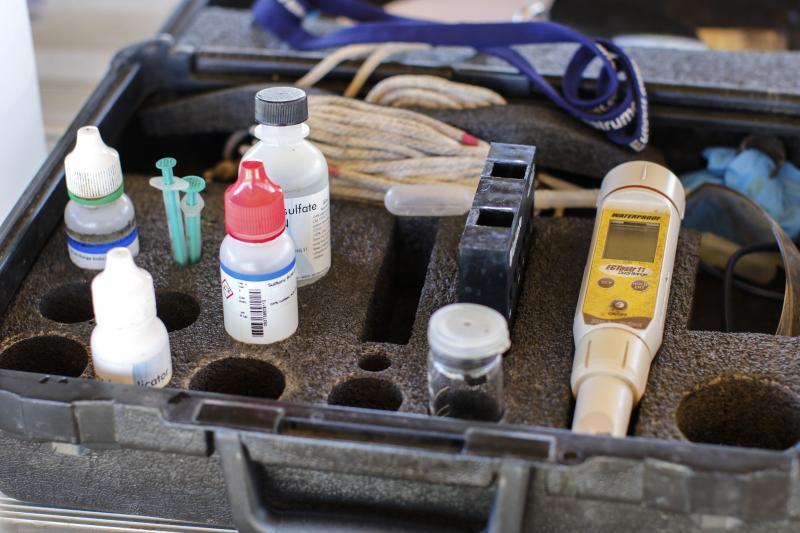When a cold snap killed an unknown number of invasive catfish last month, Rachel Sanborn was among the first to know.
Early reports were of plecostomus, or suckermouth catfish, floating in Purgatory Creek. Within days, the die-off had progressed downstream as far as Martindale, and along with the dead fish came vultures to feast upon them. Long before most people got the news, some of Sanborn’s dedicated volunteers had “spotted it immediately,” and let her know.
Not much gets past Sanborn, who has been measuring water quality in the San Marcos River for more than 20 years. For more than a decade, she has been volunteer coordinator for the San Marcos River Rangers, a diverse group of volunteers who regularly sample the water for clarity, dissolved oxygen, total suspended solids and other key indicators of the river’s overall health.

Eli Cohen and Kyle Manning examine their water sample through a ph indicator as they follow their water quality testing cheat sheet.
One recent weekend she took a group of 14 through the three-hour training required to be a state certified river monitor. As is increasingly the case, not all were locals.
“It was a pretty diverse group. We had people from San Antonio, Austin, Luling, Blanco and Wimberley along with a couple of students and a bunch from Kyle,” she recalled.
Trainings are offered every month for River Rangers, a program of the San Marcos River Foundation that also works closely with the Meadows Center for Water and the Environment and the Texas Stream Team.
Since the river foundation opened the program to people who were going to be testing waterways other than the San Marcos River training had doubled, Sanborn said. “There’s a lot of interest by other groups in taking a little more responsibility on their waterways. She said a record 100 volunteers were trained and certified in 2018 and “maybe half of them are from the San Marcos area or want to test in our area. Most of them are from other groups, even Houston — places I had to look on the map to find. They go to Texas Stream Team and see us on the map. If they’re willing to drive here we’re happy to train them.”

John Moore checks his testing paperwork while measuring the conductivity of his water sample.
She said some of those monitors have a different focus than those who concentrate on the San Marcos River, where one of the biggest concerns is sediment that is washed into the river. Yet whatever the primary concern, all the volunteers she’s trained go beyond the simple tests — they look around, and compare what they see to what they saw the last time they visited their assigned site. “A lot of it is field observation,” she said, touting the benefits of “just having eyes on the river, having a volunteer at every site once a week to look around and see if they see anything unusual or out of place.”
Some sites are manned every week though individual volunteers usually do their testing only once monthly. “We have so many volunteers we can double people up on sites and we’re actually looking into taking some sites on the Blanco close to San Marcos. Wimberley has got their area covered along with Cypress Creek.”

Some of the tools of the trade in water monitoring.
All ages are welcome to be River Rangers, she said. “Retired people tend to be the backbone of most other groups, and we have some testers that have been testing for 20 years,” Sanborn said. But younger people are stepping up too, even some teenagers. “We have high school students from San Marcos High School and some from Hays,” she said. “We have one kid who started when he was 12. He’s in high school now.”
The program also has students from Texas State and Sanborn said dealing with their changing schedules means the program has to be flexible. “We know they might be testing for a year, some for four years. It gives them experience in the field and a chance to work up some credit and boost their resume. In the long run we feel like investing in students is a great thing that might come back to them later and be useful.”
Sanborn said the training and testing isn’t complicated. “It’s great fun science. We had a Boy Scout troop that just loved it, it was like unsupervised science for them.”
For more on the River Rangers, or to sign up for a training session, visit the San Marcos River Foundations' website.







